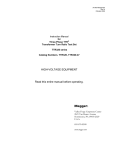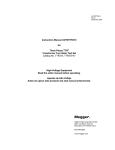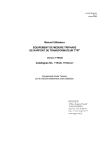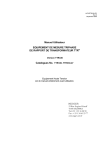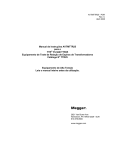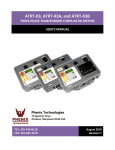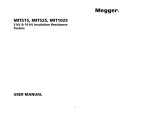Download TTR300 - BiddleMegger.com
Transcript
AVTMTTR300 Rev B Sept 2008 Instruction Manual for Three-Phase TTR® Transformer Turn Ratio Test Set TTR300 series Catalog Numbers. TTR300, TTR300-47 HIGH-VOLTAGE EQUIPMENT Read this entire manual before operating equipment M Valley Forge Corporate Center 2621 Van Buren Avenue Norristown, PA 19403-2329 U.S.A. 610-676-8500 www.megger.com Copyright © 2008 Megger. All rights reserved. The information presented in this manual is believed to be adequate for the intended use of the product. The products described herein should not be used for purposes other than as specified herein. Specifications are subject to change without notice. WARRANTY Products supplied by Megger are warranted against defects in material and workmanship for a period of one year following shipment. Our liability is specifically limited to replacing or repairing, at our option, defective equipment. Equipment returned to the factory for repair must be shipped prepaid and insured. This warranty does not include batteries, lamps, or other expendable items, where the original manufacturer's warranty shall apply. We make no other warranty. The warranty is void in the event of abuse (failure to follow recommended operating procedures) or failure by the customer to perform specific routine maintenance as indicated in this manual. M Valley Forge Corporate Center 2621 Van Buren Ave Norristown, PA 19403-2329 610-676-8500 (Telephone) 610-676-8610 (Fax) www.megger.com TABLE OF CONTENTS 1 GETTING TO KNOW THE TTR300 ......................................................................................................................5 Product Overview .......................................................................................................................................5 1.1 Top Panel Controls .......................................................................................................................7 2 SAFETY ....................................................................................................................................................................9 Safety is the responsibility of the user......................................................................................................9 General Safety Precautions ........................................................................................................................9 Input Power Precautions......................................................................................................................... 10 3 PREPARING FOR TEST ........................................................................................................................................ 13 3.1 Site Preparation........................................................................................................................... 13 3.2 Making Circuit Connections ..................................................................................................... 13 4 CONNECTING TO THE TRANSFORMER ............................................................................................................ 15 Single-Phase, Two-Winding Transformers........................................................................................... 16 Three-Phase, Two-Winding Transformers........................................................................................... 19 Three-Phase, Three-Winding Transformers ........................................................................................ 20 Current Transformers (CTs)................................................................................................................... 20 T-Type Transformers .............................................................................................................................. 27 5 OPERATION......................................................................................................................................................... 29 Power up.................................................................................................................................................... 29 Remote Control Operation for LTC Testing....................................................................................... 29 Error Messages ......................................................................................................................................... 30 Upon completion of TEST – Powering down .................................................................................... 31 6 SERVICE ............................................................................................................................................................... 33 Maintenance .............................................................................................................................................. 33 Fuse Replacement .................................................................................................................................... 33 Calibration ................................................................................................................................................. 34 TTR300 – Self check ............................................................................................................................... 34 AVTMTTR300 Rev B Sept 2008 i M Troubleshooting ........................................................................................................................................36 Repairs ........................................................................................................................................................37 7 REPLACEMENT PARTS LIST AND OPTIONAL ACCESSORIES ..........................................................................39 8 SPECIFICATIONS ..................................................................................................................................................41 Electrical .....................................................................................................................................................41 Environmental Conditions ......................................................................................................................43 ADDENDUM A .........................................................................................................................................................45 TTR 300 SERIES POWERDB LITE USER MANUAL .............................................................................................45 Introduction...............................................................................................................................................45 Software Installation .................................................................................................................................47 Using PowerDB Lite ................................................................................................................................49 Frequently Asked Questions (FAQ’s)....................................................................................................57 Specific Form Help Instructions ............................................................................................................58 AVTMTTR300 Rev B Sept 2008 ii Table of Contents List of Figures Figure 4-1. Setup for Testing Single-Phase Transformer.......................................................................... 16 Figure 4-2. Setup for Testing Single-Phase Autotransformer .................................................................. 17 Figure 4-3. Setup for Testing Single-Phase, Type A (Straight Design) Step Voltage Regulator ......... 18 Figure 4-4. Setup for Testing Single-Phase, Type B (Inverted Design) Step Voltage Regulator ........ 18 Figure 4-5. Setup for Testing Unmounted Current Transformer............................................................ 22 Figure 4-6. Setup for Testing Taps on Multiple Tap CT .......................................................................... 22 Figure 4-7. Setup for Testing BCT Mounted on Single-Phase Two-Winding Transformer ............... 23 Figure 4-8. Setup for Testing BCT Mounted on Delta Winding on a Three-Phase Power Transformer................................................................................................................................. 25 Figure 4-9. Setup for Testing BCT Mounted on Wye Winding of a Three-Phase Transformer ........ 26 LIST OF TABLES Table 4-1. Test Lead Markings for Single-Phase Transformers ............................................................. 17 Table 4-2. Test Lead Markings for Three-Phase Transformers ............................................................. 19 Table 4-3. T-type Transformer Winding Phase Relationship ................................................................. 27 Table 6-1. Troubleshooting Guide ............................................................................................................. 36 Table 7-1. Replacement Parts List .............................................................................................................. 39 AVTMTTR300 Rev B Sept 2008 iii M Upon Receipt of Product Prior to operation, check for loosened hardware or damage incurred during transit. If these conditions are found, a safety hazard is likely, DO NOT attempt to operate equipment. Please contact Megger as soon as possible. TTR300 Transformer Turn Ratio test set AVTMTTR300 Rev B Sept 2008 iv 1 Getting to know the TTR300 Product Overview The Three-Phase TTR® Test Set is fully automatic, self-checking, unit which is designed to be controlled via a computer running either PowerDB or PowerDB Lite software programs. The test set measures the turn ratio, phase shift, and excitation current of power, distribution, and instrument transformers. A “-47” suffix added to the catalog number denotes a 230-V input power supply, rather than the standard 120-V supply. The test set is a portable instrument housed in a sturdy plastic case with removable lid and carrying strap. The inside lining of case is metal shielded. A canvas carrying bag is supplied to hold all accessories. The test set can be used to test single-phase and three-phase transformers, both with and without taps in accordance with the requirements of the IEEE C57.12.90 – 1997 standards. For three-phase measurements, the test set is connected to all three phases of the transformer to be tested. The TTR lead selection circuitry permits automatic measurement of all phases without changing connections. This feature eliminates the need to refer to hook-up charts when testing three-phase transformers. Transformer excitation current as well as phase shift angle helps to detect transformer shorted turns or an unequal number of turns connected in parallel. Operating condition (error) messages identify incorrect test connections, abnormal operating condition, or winding problems. Test results are saved to an external personal computer (PC) via an RS232 serial port. Features include: Fully automatic operation. Self-checking at power-up. User-friendly, menu-driven operation (via PC) AVTMTTR300 Rev B Sept 2008 5 M Test turn ratio, phase shift (in both degree and centiradian), and excitation current. Easy measuring of regular windings, tertiary windings, and CTs. Checking reverse polarity at start of each test. Via ethernet port, an external PC or laptop is connected to operate the TTR (in remote control mode) and to transfer test results and to provide full transformer test report. Quick test mode provides the fastest testing of a transformer. Three excitation test voltages: 80 V, 40 V, and 8 V. Testing to ANSI, IEC, and Australian standards. Leads marked to ANSI, IEC, and Australian standards. Multi-lingual support. Meets the requirements of both the European EMC and Low Voltage Directives. It is recommended that the user becomes familiar with the TTR300 before ever connecting to a transformer. AVTMTTR300 Rev B Sept 2008 6 Getting to Know the TTR300 1.1 Top Panel Controls 1 4 7 5 3 2 6 Figure 1-1. Top Panel Controls 1. Power input receptacle, ON/OFF switch, and fuse holder. ON/OFF power switch and input power receptacle provides power to the test set. 2. Emergency OFF switch. This red push button interrupts testing. When pressed, the switch is locked in off position. To reset the switch, twist the button in the direction indicated by the arrows. 3. Voltage ON light. Red indicator lamp indicates when lit that test voltage is being supplied to the Unit Under Test (UUT). 4. Remote Trigger receptacle. Plug receptacle for connecting Remote Trigger cable for testing transformers with Load-Tap-Changers. 5. H – Cable receptacle. Plug receptacle for connecting test leads to the highvoltage (H) winding of a transformer 6. X – Cable receptacle. Plug receptacle for connecting test leads to the lowvoltage (X) winding of a transformer. 7. Ground lug. Wing-nut terminal allows connection of test set to Station Earth ground. AVTMTTR300 Rev B Sept 2008 7 M M AVTMTTR300 Rev B Sept 2008 8 2 Safety Safety is the responsibility of the user Only qualified and trained operators should operate the TTR300 system. Operator must read and understand this entire Instruction Manual prior to operating the equipment. Operator must follow the instructions of this Instruction Manual and attend the equipment while the equipment is in use. In the event of equipment malfunction, the unit should immediately be deenergized and returned to Megger for repair. The Safety precautions herein are not intended to replace your Company’s Safety Procedures. Refer to IEEE 510 1983, IEEE Recommended Practices for Safety in High-Voltage and HighPower Testing, for additional information. General Safety Precautions The TTR300 and the Unit Under Test (UUT) should both be considered as sources of instantaneously lethal levels of electrical energy. Observe the following safety precautions: Observe all safety warnings on the equipment. They identify areas of immediate hazard that could result in injury or death. Use this equipment only for the purposes described in this manual. Observe strictly the Warning and Caution information provided in this manual Treat all terminals of high-voltage power equipment systems as potential electric shock hazards. Use all practical safety precautions to prevent contact with energized parts of the equipment and related circuits. Use suitable barriers, barricades, or warnings to keep persons not directly involved with the work away from test activities. Never connect the test equipment to energized equipment. AVTMTTR300 Rev B Sept 2008 9 M Do not use in an explosive atmosphere. Use the grounding and connection procedures recommended in this manual. Always disconnect test leads from power equipment before attempting to disconnect them at the test set. The ground connection must be the first made and the last removed. Any interruption of the grounding connection can create an electrical shock hazard. Personnel using heart pacemakers should obtain expert advice on the possible risks before operating this equipment or being close to the equipment during operation. Input Power Precautions This instrument operates from a single-phase, sine wave, power source. It has a three-wire power cord and requires a two-pole, three-terminal (live, neutral, and ground) type input source. The voltage to ground from the live pole of the power source must be within the following rated operating voltage: For Cat. No TTR300 120 V ±10%, single phase sine, 50/60 ±2 Hz For Cat. No. TTR300-47 230 V ±10%, single phase sine, 50/60 ±2 Hz The neutral pole must be at ground potential. Before making connection to the power source, determine that the instrument rating matches the voltage of the power source. The power input plug must be inserted only into a mating receptacle with a ground contact. Do not bypass the grounding connection. Any interruption of the grounding connection can create an electric shock hazard. Determine that the receptacle is properly wired before inserting the plug. For test sets energized with 230 V input (TTR300-47), the neutral terminal of the input supply cord (white or blue lead) must be connected to the neutral pole of the line power source. The ground terminal of the input supply cord (green or yellow/green lead) must be connected to the protective ground (earth) terminal of the line power source. The black or brown cord lead is the live (hot) lead. The control circuits of the instrument are protected by two mains circuit fuses. These fuses are located in the ON/OFF switch module and are replaceable by the operator. To avoid electric shock and fire hazard, use only the fuse specified in Sections 1 and 8, that is identical in respect to type, voltage rating, and current rating. Refer to the Fuse Replacement procedure in the Service section. AVTMTTR300 Rev B Sept 2008 10 Safety WARNING Before replacing the fuses, disconnect the power input plug from the live power source. AVTMTTR300 Rev B Sept 2008 11 M M AVTMTTR300 Rev B Sept 2008 12 3 PREPARING FOR TEST 3.1 Site Preparation Choose a location that meets the following conditions: 3.2 The location is as dry as possible. There is no flammable material stored in the vicinity. The test area is adequately ventilated. Be sure all equipment is de-energized and all terminals of the UUT are accessible. Erect suitable safety barriers to protect the operator from traffic hazards and to prevent intrusion by unauthorized personnel. User provided Warning lights are recommended. Verify that the Local station ground is intact and has impedance continuity to earth. Making Circuit Connections Connections should be made in the order as listed below. 3.2.1 Ground. Use the Megger supplied Safety Ground Cable 15 ft (4.6 m) to connect the TTR300 Wing Nut Ground Terminal directly to Local Station Earth ground. Ensure the Transformer chassis also has impedance continuity to Local Station Earth ground potential. 3.2.2 Input Power Source Ground. Input Power Source Ground Terminal should be less than 100 milliohms of impedance to Local Station Earth Ground. 3.2.3 Connect the Input Power Cord. Before making this connection, Ensure the Input Power Source meets the requirements as listed in AVTMTTR300 Rev B Sept 2008 13 M Section 2 and Specifications Section 8. Also make sure that the ON/OFF switch (Figure 1-1, No. 1) is in the OFF position. Connect the input power cable to the TTR300 first, then to the power source. At this time, leave the ON/OFF switch in the OFF position. 3.2.4 Connect the Serial cable. For operation of the TTR300 in a remotecontrol mode, using PowerDB PC software, then connect the Serial cable between the TTR300 and the PC at this time. 3.2.5 Connect the Load-Tap-Changer cable (optional). If the user chooses to operate the “Test button” of the TTR300 from a remote distance then, connect the LTC cable at this time. 3.2.6 Connect the H and X leads (to the TTR300 end only at this time). With the clamps disconnected from the UUT, connect the Bayonet Plug on the Cable labeled “H” to the TTR panel connector also labeled “H”. Repeat this process for the “X” labeled cable. Ensure each connector is securely fastened using a clockwise rotation. 3.2.7 Connect the H and X clamps. With the ON/OFF Switch in the OFF position, connect the H and X clamps in accordance with Section 4 as appropriate for the specific transformer type and test to be conducted. AVTMTTR300 Rev B Sept 2008 14 4 Connecting to the Transformer The setup and connection instructions included in Section 4 herein, pertaining to ratio, polarity, and phase relation, assume that the transformer under test, connections, and terminal markings comply with the requirements of ANSI C57.12.70-1990 American National Standards Terminal Markings and Connections for Distribution and Power Transformers. The H test leads of the test set are the exciting (high voltage) leads (8 V, 40 V, or 80 V). The X test leads are the low voltage leads. When testing high-voltage transformers, caution must be used at all times and all safety precautions followed. Read, understand, and employ all safety precautions and circuit connections described in Sections 2 and 3 herein. WARNING Ensure that the transformer to be tested is completely de-energized. Check every winding. Ensure that all terminals of the transformer are disconnected from line or load at the transformer. Connections to ground may be left in place. WARNING For all testing as described herein, care shall be taken to ensure any and all unused clamps shall be isolated from each other, from ground, and from personnel. WARNING Except for CTs as described herein, never interchange connections between the high- and low-voltage transformer terminals. Failure to observe proper connections will result in a safety hazard and may result in damage to the test set or transformer. AVTMTTR300 Rev B Sept 2008 15 M Single-Phase, Two-Winding Transformers Perform the following setup procedure for single-phase, two-winding transformers: 1. With the ON/OFF Switch in the OFF position, make the circuit connections as described in Section 3.2. 2. Connect the H and X test cables to the respective H and X receptacles of the TTR300. Make sure that the connectors are securely fastened (using clockwise rotation) to the receptacles. 3. Connect the heavy-duty clamps marked H1 and H2 of the test lead to the corresponding (high-voltage winding) terminals of the transformer under test. Figures 4-1 and 4-2 show test setups for single-phase transformers. Figures 4-3 and 4-4 show test setups for regulators. 4. Connect the heavy-duty clamps marked X1 and X2 of the test lead to the corresponding (low-voltage winding) terminals of the transformer under test. Figures 4-1 and 4-2 show test setups for single-phase transformers. Figures 4-3 and 4-4 show test setups for regulators. 5. On/OFF Switch. It is only after all of the above connections are safely made and all safety precautions of sections 2 and 3 are satisfied, should the On/OFF switch be turned to the ON position. Figure 4-1. AVTMTTR300 Rev B Sept 2008 Setup for Testing Single-Phase Transformer 16 Connecting to the Transformer Figure 4-2. Setup for Testing Single-Phase Autotransformer To test windings other than H1 – H2 and X1 – X2, ensure that the heavy-duty clamp marked H1 is connected to the lower numbered terminal and H2 to the higher numbered terminal of the high-voltage winding. Similarly, X1 and X2 should be connected to the low-voltage winding. Test lead markings for the ANSI, CEI/IEC, and Australian standards are as shown in Table 4-1. Table 4-1. Test Lead Markings for Single-Phase Transformers Test Lead Marking Transformer Heavy-Duty Clamp Test Lead Boot Color Color Band ANSI CEI/IEC Australian Terminal Voltage H1 1U A2 High Red Red H2 1V A1 High Red Yellow X1 2U a2 Low Black Red X2 2V a1 Low Black Yellow AVTMTTR300 Rev B Sept 2008 17 M Figure 4-3. Setup for Testing Single-Phase, Type A (Straight Design) Step Voltage Regulator Figure 4-4. Setup for Testing Single-Phase, Type B (Inverted Design) Step Voltage Regulator AVTMTTR300 Rev B Sept 2008 18 Connecting to the Transformer Three-Phase, Two-Winding Transformers Perform the following setup procedure for three-phase, two-winding transformers: 1. With the ON/OFF Switch in the OFF position, make the circuit connections as described in Section 3.2. 2. Connect the H and X test cables to the respective H and X receptacles of the TTR300. Make sure that the connectors are securely fastened (using clockwise rotation) to the receptacles. 3. Connect the heavy-duty clamps marked H0, H1, H2, and H3 of the test lead to the corresponding (high-voltage winding) terminals of the transformer under test. Refer to Table 4-2 for test lead markings. With delta connected windings, H0 is not used. With wye connected windings, a neutral connection for H0 is normally available. 4. Connect the heavy-duty clamps marked X0, X1, X2, and X3 of the test lead to the corresponding (low-voltage winding) terminals of the transformer under test. Refer to Table 4-2 for test lead markings. With delta connected windings, X0 is not used. With wye connected windings, a neutral connection for X0 is normally available. 5. On/OFF Switch. It is only after all of the above connections are safely made and all safety precautions of sections 2 and 3 are satisfied, should the On/OFF switch be turned to the ON position. Table 4-2. Test Lead Markings for Three-Phase Transformers Test Lead Marking Transformer Heavy-Duty Test Lead Clamp ANSI CEI/IEC Australian Terminal Voltage Boot Color Color Band H0 1N N Neutral Red White H1 1U A2/A4 High Red Red H2 1V B2/B4 High Red Yellow H3 1W C2/C4 High Red Blue X0 2N N Neutral Black White X1 X2 X3 2U 2V 2W a1/a2/a4 b1/b2/b4 c1/c2/c4 Note: AVTMTTR300 Rev B Sept 2008 Low Low Low Black Black Black Red Yellow Blue According to Australian standard, wye and delta transformer winding connections have a numerical suffix of 1 and 2. The zigzag transformers have a numerical suffix of 4. See Table A-3. 19 M Three-Phase, Three-Winding Transformers This type of transformers has primary, secondary, and tertiary windings. Primary and secondary windings are tested as a regular three-phase, two-winding transformer. To test tertiary winding, perform the following setup procedure: 1. With the ON/OFF Switch in the OFF position, make the circuit connections as described in Section 3.2. 2. Connect the H and X test cables to the respective H and X receptacles of the TTR300. Make sure that the connectors are securely fastened (using clockwise rotation) to the receptacles. 3. Connect the heavy-duty clamps marked H0, H1, H2, and H3 of the test lead to the corresponding terminals of the transformer under test. Refer to Table 4-2 for test lead markings. With delta connected windings, H0 is not used. With wye connected windings, a neutral connection for H0 is normally available 4. Connect the heavy-duty clamps marked X0, X1, X2 , and X3 of the test lead to the corresponding tertiary (low-voltage winding) terminals (Y0, Y1, Y2, and Y3) of the transformer under test. Refer to Table 4-2 for test lead markings. With delta connected windings, X0 is not used. With wye connected windings, a neutral connection for X0 is normally available. 5. On/OFF Switch. It is only after all of the above connections are safely made and all safety precautions of sections 2 and 3 are satisfied, should the On/OFF switch be turned to the ON position. Current Transformers (CTs) Connections to CTs are made backwards compared to power or potential transformers. The H terminals on the test set must be connected to the X terminals on the CT; and the X terminals on the test set must be connected to the H terminals on the CT. NOTE: AVTMTTR300 Rev B Sept 2008 Dots on the housing of the transformer are commonly used to identify terminals of the same polarity. 20 Connecting to the Transformer WARNING Failure to observe proper connections will result in a safety hazard and may result in damage to the test set or CT. Failure to observe voltage rating of low-current X winding may result in damage to the CT. CAUTION Never use AUTO mode of operation when testing the current transformers with the rated voltage below 80 V ac. Most of the CTs are tested at 8 V ac excitation voltage. NOTE: Most of the current transformers are tested at 8 V ac excitation voltage. Some current transformers with turn ratio of 100:5 and less get saturated at 8V ac. They require lower excitation voltage for testing and therefore can not be tested with the Cat.No TTR300. For this case, use the TTR100 or TTR25. Unmounted CTs 1. With the ON/OFF Switch in the OFF position, make the circuit connections as described in Section 3.2. 2. Connect the H and X test cables to the respective H and X receptacles of the TTR300. Make sure that the connectors are securely fastened (using clockwise rotation) to the receptacles. 3. As shown in Figure 4-5, connect the heavy-duty clamps marked H1 and H2 of the test lead to the respective X1 and X2 terminals of the CT. Note that the H and X leads are connected in reverse as compared to the Single and Three phase Transformer testing described in the previous sections. 4. As shown in Figure 4-5, connect the heavy-duty clamps marked X1 and X2 of the test lead to the respective H1 and H2 terminals of the CT. Ensure correct polarity. Note that the H and X leads are connected in reverse as compared to the Single and Three phase Transformer testing described in the previous sections. AVTMTTR300 Rev B Sept 2008 21 M Figure 4-5. Setup for Testing Unmounted Current Transformer Figure 4-6 shows the setup for testing the taps on a multiple-tap CT. Figure 4-6. AVTMTTR300 Rev B Sept 2008 Setup for Testing Taps on Multiple Tap CT 22 Connecting to the Transformer Bushing Current Transformer (BCT) Mounted on Single-Phase, Two-Winding Transformer A turn-ratio test can be performed on a BCT after it has been mounted on a circuit breaker or power transformer entrance bushing. The test can be performed without removal of the BCT from the equipment. Proceed as follows: 1. With the ON/OFF Switch in the OFF position, make the circuit connections as described in Section 3.2. 2. Connect the H and X test cables to the respective H and X receptacles of the TTR300. Make sure that the connectors are securely fastened (using clockwise rotation) to the receptacles. 3. Using user supplied shorting jumper leads, short-circuit the winding on the opposite voltage side of the power transformer core. 4. Connect the heavy-duty clamps marked H1 and H2 of the test leads to the respective X1 and X2 terminals of the BCT as shown in figure 4-7. 5. Connect the heavy-duty clamp marked X1 to the power transformer terminal on which the BCT is mounted and the X2 heavy-duty clamp to the terminal on the opposite side of the power transformer winding (H2 side of BCT). Check to make sure that the BCT is mounted with proper polarity with respect to power transformer entrance bushing and that connection polarities are correct. Figure 4-7. Setup for Testing BCT Mounted on Single-Phase Two-Winding Transformer AVTMTTR300 Rev B Sept 2008 23 M BCTs Mounted on Three-Phase Transformers A turn-ratio test can be performed on all three BCTs using a single setup. Figure 4-8 shows how (to make the proper connections) when the BCTs are mounted on a typical delta winding and Figure 4-9 shows how when mounted on a typical wye winding. 1. With the ON/OFF Switch in the OFF position, make the circuit connections as described in Section 3.2. 2. Connect the H and X test cables to the respective H and X receptacles of the TTR300. Make sure that the connectors are securely fastened (using clockwise rotation) to the receptacles. 3. Short-circuit all windings on the opposite voltage side of the power transformer core using jumper leads. 4. Check to make sure that all BCTs are mounted with proper polarity with respect to the power transformer entrance bushing. Ensure that all connection polarities are correct. Make connections as shown in figure 4-8 for delta winding configurations and figure 4-9 for wye winding configurations. AVTMTTR300 Rev B Sept 2008 24 Connecting to the Transformer Figure 4-8. Setup for Testing BCT Mounted on Delta Winding on a Three-Phase Power Transformer AVTMTTR300 Rev B Sept 2008 25 M Figure 4-9. Setup for Testing BCT Mounted on Wye Winding of a Three-Phase Transformer AVTMTTR300 Rev B Sept 2008 26 Connecting to the Transformer T-Type Transformers T-type transformers represent a special type of thee-phase transformer. This transformer may be tested as a single phase transformer. In this case, the jumpers indicated in Table 4-3 should be applied to the appropriate terminals of the Ttype transformers. The TTR measured turn ratio should be compared to the calculated turn ratio indicated in Table 4-3. Table 4-3. T-type Transformer Winding Phase Relationship Winding Connection IEC Vector Group High-Voltage Winding (H) Low-Voltage Winding (X) External jumpers VH H1 -H2 X1 -X2 B H1 – H3 H2 -H3 A H1 – H3 X 1 - X2 VH 3 • VX 2 B H2 – H3 X1 – X3 VH 2 • VX 3 H2 -H3 A H1 – H3 X 1 – X3 VH 3 • VX 2 X1 –X3 B H2 – H3 X 2 – X1 VH 2 • VX 3 27 VX VH X1 -X2 AVTMTTR300 Rev B Sept 2008 X 1 - X2 Calculated Turn Ratio H1 - H2 T-T 30 lag T-T 30 lead Winding Tested HighLowVoltage Voltage Winding Winding A T-T 0 Phase tested X1 – X3 VX Remarks M M AVTMTTR300 Rev B Sept 2008 28 5 Operation Power up Proceed only after reading and fully reading and understanding Sections 2, 3, and 4 herein, with particular attention on the Safety related precautions. Once all Safety precautions are taken, and all circuit connections are made, then the user may safely turn the ON/OFF switch to the ON position and operate the test instrument as described herein. EMERGENCY SHUTDOWN For Emergency shutdown, Push red EMERGENCY OFF button or toggle On/OFF switch to OFF. On power up, a beep sounds, the test set performs a self-test check, and all hardware and software variables are initialized. Proceed to Addendum A for operation via external PC (supplied by User). Remote Control Operation for LTC Testing Use the remote control mode of the TTR for load tap changer (LTC) testing. The remote control mode provides two-way-communication between the operator and the TTR, allowing you to stay close to an LTC, change taps, and initiate the test routine. Connect the hand-held control unit, Megger p/n 30915-220, to the Remote Trigger Receptacle port of the TTR. The remote control unit pushbutton lamp will illuminate. Now an operator may come to the remote location, and set (for example), the LTC to the desired position, and would then depress the remote control unit pushbutton for a short time, then release it. The pushbutton lamp extinguishes AVTMTTR300 Rev B Sept 2008 29 M until the TTR is ready for the next test. When the current testing is complete, the test results are automatically saved, the pushbutton lamp lights, and the TTR test set is ready for the next remote test Error Messages When an error message appears, indicating an abnormal operating condition, verify the condition by taking a repeat measurement before attempting to take any corrective action. Open connections, wrong connections, open windings, shorted windings, high resistance windings, other abnormal transformer problems, or a combination of these may cause a large deviation from normal turn ratio or indicate an unusual message. The unusual operating conditions may be caused by an abnormal leakage reactance or capacitive coupling within the transformer windings. If abnormal operating conditions occur during transformer testing, error messages may appear (such as below) and may be accompanied by three short beeps. CHECK CONNECTIONS This message indicates that the transformer is not connected to the test set. The message may be caused by poor connection of one of the test leads, as well. PHASE A (or B, or C) EXCITATION CURRENT TOO HIGH This message indicates that excitation current exceeds 500 mA. Excitation current can be reduced by using lower test voltages (40 V or 8 V). TURNS RATIO TOO LOW, <0.8 This message shows that a transformer under test turn ratio is less than 0.8. The TTR is not designed to test a transformer turn ratio under 0.8. PHASE A (or B, or C) TURNS RATIO TOO HIGH This message shows that a transformer under test turn ratio is higher than 10,000 (if 80 V or 40 V is used) or is higher than 4,000 (if 8 V is used). The message may be caused by poor connection of one of the test leads, as well. CHECK PHASE A (or B, or C) CONNECTIONS, REVERSED This message is caused by incorrect connection of the H and X leads. The H and X leads have either been reversed or the test transformer connections or AVTMTTR300 Rev B Sept 2008 30 Operation markings do not comply with the requirements of ANSI, IEC, or the Australian standard. The message may be caused by wrong diagram number specified, as well. CHECK PHASE A (or B, or C) POLARITY This message shows that the H or X test leads are incorrectly connected or the test transformer connections or markings do not comply with the requirements of ANSI, IEC, or the Australian standard. Upon completion of TEST – Powering down 6.1 Upon completion of testing, once directed by the on-screen instruction, Switch the ON/OFF Switch to OFF. 6.2 Using an adequately grounded Safety Ground Stick, ground all exposed high voltage connections. Then, while wearing the appropriately rated rubber gloves, connect Safety Ground Jumpers from all exposed high voltage cable terminals to Local Station Earth Ground. It is a good idea to leave the jumpers in place for at least as long as the specimen was at test voltage. 6.3 Remove the Test Instrument clamps from the Transformer, leaving the Safety Ground Jumper in place to drain any stored charge. 6.4 Disconnect the Power Cord from the Input Power Source. 6.5 Lastly, disconnect the safety ground cable. AVTMTTR300 Rev B Sept 2008 31 M M AVTMTTR300 Rev B Sept 2008 32 6 Service Maintenance Maintenance should be performed only by qualified persons familiar with the hazards involved with high-voltage test equipment. Read and understand Sections 2, 3, 4, and 5 before performing any service. The TTR300 requires only periodic inspection. Periodically, inspect all hardware items including the cable assemblies to ensure all is in good condition. The TTR300 may be cleaned periodically. In so doing, do not allow water to penetrate panel holes. An all-purpose, household spray cleaner can be used to clean the panel. Polish with a soft, dry cloth, taking care not to scratch the display screen cover. Clean the cables and mating panel receptacles with isopropyl or denatured alcohol applied with a clean cloth. Fuse Replacement The TTR300 is protected by two mains fuses. Fuse replacement is indicated if the electronic circuits do not function. Refer fuse replacement to qualified personnel only. To avoid electric shock and fire hazard, use only the fuses specified on Instrument panel. WARNING Before replacing the fuses, disconnect the power input plug from the live power source. To replace fuse(s), proceed as follows: 1. Disconnect the power cord from the TTR test set. 2. Using a small flathead screwdriver, carefully pry out the fuse holder of the input power module (item 1 of figure 1.1). AVTMTTR300 Rev B Sept 2008 33 M 3. Remove and properly dispose of spent fuse(s). 4. Install new fuse(s) making sure to use the type specified on Instrument panel. 5. Reinstall the fuse holder in its receptacle in the input power module. Connect the power cord to the TTR test set and to an energized power source. If the electronic circuits still do not function properly, contact the factory for service. Calibration A complete performance and calibration check should be made at least once every year. This will ensure that the TTR test set is functioning and calibrated properly over the entire measurement range. The 3-phase TTR calibration is performed on each new or repaired unit before sending it to a customer. There is a special 3-phase TTR final calibration procedure which requires a NISTtraceable test equipment to be used. As a result of such calibration procedure, each TTR test set may be NIST certified. To check the 3-phase TTR calibration at a customer site or in the field, the Megger Calibration Standard Cat. No. 550055 or equivalent standard should be used. To perform a quick simplified calibration check, the Megger Calibration Standard Cat No. 550555 may be used. The last standard has eleven switchable turns ratio settings which cover the turns ratio range from 1:1 to 2000:1. TTR300 – Self check A customer may want to make sure that the test set is functioning properly before testing a transformer. Traditionally, for transformer turns ratio testers, a customer performed this test by connecting H1-X1 and H2-X2 test leads. The 1:1 turns ratio was expected to be measured. Additionally, the displayed test results were interpreted as a test set calibration check. The 3-phase TTR test set is designed and optimized for the transformer turns ratio testing. It uses a mixed analog-digital technique to provide the high accurate readings of the tested transformer turns ratio. The test set measurement approach is based on high impedance input and output transformer voltage monitoring circuits. The high impedance of the monitoring circuits is optimized for the accurate transformer turns ratio testing. When performing a 3-phase TTR functional test, the H and X test leads interconnect the input and output monitoring circuits without a transformer being connected. Such connection cause an impedance mismatch and, as a result of the mismatch, the displayed turns ratio reading is not exactly 1:1 as it may be expected. A customer should be aware that a functional test is not a real transformer turns ratio test. Due to the intrinsic and inevitable impedance AVTMTTR300 Rev B Sept 2008 34 Replacement Parts List and Optional Equipemtn mismatching, the 3-phase TTR functional test readings may be from 0.9980 to 1.0020. The TTR functional test readings do not represent its calibration. It simply shows that the TTR test set circuitry functions properly. To check the 3phase TTR calibration, a customer should use the Calibration Standards mentioned in Calibration section of the manual. To perform a 3-phase TTR functional test proceed as follows: 1. Turn TTR test set power off. 2. Connect H1 and X1 clamps to an electrically common point (such as an unused bare wire). Likewise, electrically connect the H2 and X2 clamps, the H3 and X3 clamps, and lastly, the H0 and X0 clamps. Directly connecting two clamps together may cause erroneous results as it is very difficult to have all four sides (within the two clamps) make contact with each other (as the TTR300 utilizes “Kelvin” type leads, it is necessary, for this 1:1 quick check, that all four sides of each clamp pair are electrically common). Also, make sure the leads are properly connected and that H/X pairs are not electrically in contact with each other. 3. Turn TTR test set power on. 4. After self-test is complete and the unit is ready for testing: 5. Enter transformer type DIAG 07 YNyn0. WARNING Do not continue functional test if the diagram type DIAG 07 YNyn0 transformer type is not listed. Keep the leads, which are energized, clear of ground, and personnel, and each of the other lead-pair sets. 6. Start TEST 7. The readings for phases A, B, and C should be: RATIO: 1.0000 ±0.0020 PHASE(min): 0 ±5 Iexc (mA): 0.0 to 0.5 8. If needed, (as identified on the Preference screen), perform the test according to steps 1 through 7 for all the excitation voltages of 8V, 40 V, and/or 80V. The readings should be the same as shown in step 7. AVTMTTR300 Rev B Sept 2008 35 M Troubleshooting The Troubleshooting Guide, Table 6-1, is arranged to help you evaluate the reasons for TTR test set malfunction. The table lists possible test set malfunctions which may be encountered during operation and lists possible causes. Electronic circuit repairs should not be attempted in the field. Refer to Repair section. Refer to Section 7 for a list of spare parts. Table 6-1. Troubleshooting Guide MALFUNCTION Unit is not communicating or responding to commands. Error message: ANALOG OFFSET VOLTAGE HIGH POSSIBLE CAUSE No service power. Defective line cord. Defective fuse(s). Defective display or electronics. Out of tolerance condition(s) in measurement circuit. and/or ANALOG GAIN OUT OF TOLERANCE appears after self-test is complete. Red TEST VOLTAGE ON lamp does not light on start of testing. One of the following messages appear on the test result screen. Defective lamp. EMERGENCY TEST OFF switch is not released. Problem in measuring circuit. Abnormal operating condition. Incorrect setting of TRANSFORMER TYPE in the quick test setup or the full test setup 1 menus. CHECK CONNECTIONS PHASE A (or B, or C) EXCITATION CURRENT TOO HIGH; Incorrect connection of leads. TURNS RATIO TOO LOW, <0.8; or PHASE A (or B, or C) TURNS RATIO TOO HIGH; Defective test leads. CHECK PHASE A (or B, or C) CONNECTIONS, REVERSED; Incorrect marking of a transformer. Problem in test specimen. CHECK PHASE A (or B, or C) POLARITY Problem in measuring circuit. Defective test leads (open circuit, poor connection). Severe abnormal transient in service power. Problem in test specimen (poor connection). Problem in measuring circuit. RATIO and/or Iexc (mA) readings erratic. AVTMTTR300 Rev B Sept 2008 36 Replacement Parts List and Optional Equipemtn Repairs Any service or repair of this equipment should be performed only by qualified persons who are aware of electrical hazards and the necessary precautions required to prevent injury. Megger offers a complete Repair and Calibration Service and recommends that its customers take advantage of this service for routine maintenance or in the event of any equipment malfunction. In the event Service is required, contact your Megger representative for a product Return Authorization (RA) number and shipping instructions. Ship the product prepaid and insured and marked for the attention of the Megger Repair Department. Please indicate all pertinent information, including catalog number, serial number, and problem symptoms. AVTMTTR300 Rev B Sept 2008 37 M M AVTMTTR300 Rev B Sept 2008 38 7 Replacement Parts List and Optional Accessories Table 7-1. Replacement Parts List Item Cat. No. Three-phase Transformer Turns Ratio Test Set 120 V ac ±10%, single phase, 50 ±2 Hz or 60 ±2 Hz, 100 VA TTR300 230 V ac ±10%, single phase, 50 ±2 Hz or 60 ±2 Hz, 100 VA TTR300-47 Included Accessories Canvas carrying bag for test leads 30915-211 Power supply cord, 8 ft (2.5 m) 17032-4 Ground lead, 15 ft (4.6 m) 4702-7 Hand-held switch assembly for LTC remote control testing 30915-220 PowerDB Lite Software Serial cable for connecting to a PC 35248 Bushing clamps (6 pcs) MC7144 Instruction manual AVTMTTR300 Optional Accessories Calibration Standard (for Operation Check) 550555 Inverter with 3 ft (0.91 m) cigarette adapter cord: 12 V dc to 120 V ac, 60 Hz 35271-1 12 V dc to 120 V ac, 50 Hz 35271-3 12 V dc to 230 V ac, 60 Hz 35271-2 12 V dc to 230 V ac, 50 Hz 35271-4 AVTMTTR300 Rev B Sept 2008 39 M Item Cat. No. Test Leads 1-phase lead-set, shielded, clamp-end terminated H and X windings, 30 ft (9.1 m) 37095 3-phase lead-sets, shielded, clamp-end terminated H and X windings, 30 ft (9.1 m) 37093 H and X windings, 50 ft (15 m) 37094 Transit case for instrument leads and accessories 37009 Field Upgrade kits TTR330 Interface panel 37089-1 TTR320 Interface panel 37089-2 TTR310 Interface panel 37089-3 TTR300 Interface panel 37089-4 AVTMTTR300 Rev B Sept 2008 40 8 Specifications Electrical Input Power Cat. No. TTR300: 120 V ac ±10%, single phase, sine, 50 ±2 Hz or 60 ±2 Hz, 100 VA, IEC 1010-1 installation category II Cat. No. TTR300-47: 230 V ac ±10%, single phase, sine, 50 ±2 Hz or 60 ±2 Hz, 100 VA, IEC 1010-1 installation category II Protective Devices Fuses (2): Cat. No. TTR300: Type T, 250 V, 3.5A (IEC 127 designation) Cat. No. TTR300-47: Type T, 250 V, 1.5 A (IEC 127 designation) High voltage and low voltage measurement circuit shorting relays Heavy duty varistors, transient voltage suppressors, and gas surge voltage protectors Output Test Voltage and Current 3 test voltages: 80 V rms, 40 V rms, 8 V rms. Current: up to 500 mA Test Frequency Same as line frequency. Loading of Test Transformer Less than 0.2 VA AVTMTTR300 Rev B Sept 2008 41 M Measuring Ranges Turn ratio: 80 V ac: 0.8 to 45,000, 5 digit resolution 40 V ac: 0.8 to 25,000, 5 digit resolution 8V ac: 0.8 to 8,000, 5 digit resolution Excitation Current: 0 to 500 mA, 3 digit resolution Phase Angle Deviation: ± 90 degrees, 1 decimal point for the minutes display, 2 decimal point for the degree display, 2 decimal points for the centiradian display Accuracy Turn ratio: 80 V ac: ±0.1% (0.8 to 2000) ±0.15% (2001 to 4000) ±0.25% (4001 to 10000) ±0.3% (10001 to 45000) 40 V ac: ±0.1% (0.8 to 2000) ±0.15% (2001 to 4000) ±0.3% (4001 to 10000) ±0.35% (10001 to 25000) 8 V ac: ±0.1% (0.8 to 2000) ±0.25% (2001 to 4000) ±0.35% (4001 to 8000) Excitation Current (rms): ±(2% of reading + 1 digit) Phase Angle Deviation: ±3 minutes Measurement Method In accordance with ANSI/IEEE C57.12.90 Transformer Winding Phase Relationship ANSI C57.12.70-1990 CEI/IEC 76-1:1993 and Publication 616:1978 AS-2374, Part 4-1997 (Australian Standard) AVTMTTR300 Rev B Sept 2008 42 Specifications Measuring Time 10 to 20 seconds depending on mode of operation and type of transformer Display Via external PC (user supplied) Memory Storage Via external PC (user supplied) Interface RS232 Serial Environmental Conditions Operating temperature range: 23° to 122°F (-5 to 50 °C) Storage temperature range: -58° to 140°F (-50 to 60 °C) Relative humidity: 0 to 90% noncondensing (operating) 0 to 95% noncondensing (storage) Physical Data Dimensions: 21.5 x 13.5 x 8.5 in. (44.5 x 26.5 x 17.5 cm) (L x W x H) Weight (test set): 25 lbs. (11.5 kg) Case: Ruggedized plastic case with removable lid and carrying strap AVTMTTR300 Rev B Sept 2008 43 M M AVTMTTR300 Rev B Sept 2008 44 Addendum A TTR 300 Series PowerDB Lite User Manual Introduction PowerDB Lite is a free, but limited capability, version of the PowerDB software tool that is designed specifically to control and/or extract data from Megger instruments. The primary difference between PowerDB Lite and PowerDB is that PowerDB is designed to work with all manufacturers’ equipment and has field and office synchronization capabilities. PowerDB Lite will present your test data into a professional looking data form that can be sent to a printer or .pdf file distiller such as PDF995. PowerDB Lite allows you to use a sub-set of the standard PowerDB forms that are appropriate for specific Megger instruments. PowerDB Lite detects the instrument and enables the appropriate form(s). Data can be entered on-screen or captured directly while using the test instrument. Completed data forms can be saved as files to your computer. Minimum Recommended System Operating System: RAM: Processor: 300 MHz Pentium Class processor minimum, 1 GHZ or better recommended Windows 2000 or later 64 MB RAM minimum, 512+ MB RAM recommended For information about the features of the full version of PowerDB please visit our website at www.powerdb.com. Get acquainted with the following features by scheduling a live demonstration at [email protected] Synchronize All of Your Test Records Into a Single Corporate Database Reduce Test Time Improve Data Integrity AVTMTTR300 Rev B Sept 2008 45 M Standardize Test Procedures Easily Use Historical Trending for Evaluation of Test Results Eliminates the Need to Install and Maintain a Software Application per Instrument Eliminates All Hand Written Test Sheets Create Your Own Test Forms Use or Modify One of Our 200 Built-in Test Forms One Step Procedure To Generate Test Reports With Table of Contents and Deficiency Summaries Allows All Of Your Field Test Data To Be Integrated With CMMS Systems Such As Maximo or SAP Imports >From Many Other Industry Standard Software Applications Controls and Imports Data From Many non-Megger Instruments AVTMTTR300 Rev B Sept 2008 46 TTR Series PowerDB Lite User Manual Software Installation To install PowerDB Lite, load the PowerDB Lite CD into your CD-ROM drive and follow the on-screen instructions. 1. Accept the terms of the License agreement. 2. Choose the destination location for the PowerDB Lite files. AVTMTTR300 Rev B Sept 2008 47 M 3. Select Default Settings. 4. InstallShield Wizard will complete the installation of PowerDB Lite. Click Finish to close the installation program. AVTMTTR300 Rev B Sept 2008 48 TTR Series PowerDB Lite User Manual Using PowerDB Lite 1. Home 1. Select your Instrument from the Instrument Setup screen. a. You can always view the Instrument Setup screen from the Tools menu or F3. b. Select the appropriate row in the Description column. Then click the “...” button in the Setup column. c. The TTR 300/310 only uses serial communicate, so never check ‘Use Ethernet’ if you are using a TTR 300 or TTR 310. Select the appropriate communication settings on the Serial Device Configuration screen. Use the Refresh button to find any ports that may have not been connected at the startup of PowerDB Lite. If you are using a USB serial port and do not know the port assigned to it please perform the following: 1. Remove the USB serial adapter 2. Press Refresh 3. Click on the port drop down and record the options 4. Plug the adapter back in 5. Press refresh AVTMTTR300 Rev B Sept 2008 49 M 6. Select the port that was not in the original list Verify that the baud rate is set to 9600, Parity is set to none, Byte Size is set to 8, and Stop Bits is set to 1. d. Only check ‘Use Ethernet’ if connected to the TTR330. If you leave the IP address blank PowerDB Lite will discover the unit. If you have problems with the discovery enter the IP address which is displayed on the instrument’s Preferences screen. e. Then Click OK on the Instrument Setup Screen to finish. 2. Open a New Form a. Select the File>New menu item, or type CTRL+N, or press the New toolbar button. b. The forms associated with the detected instrument will be shown in the Select a Form screen. c. Choose a form by double-clicking or by navigating with the arrow keys and pressing the OK key. d. See Specific Form Help Instructions for further instruction on test steps. You can view the Form Help by pressing the F1 key once the form is loaded. AVTMTTR300 Rev B Sept 2008 50 TTR Series PowerDB Lite User Manual 3. Enter Test Data a. Header and nameplate information can be manually typed into a form. b. Click the Initialize Instrument button to initialize the test set. c. Form fields with automation will now be colored cyan. Right-clicking these fields will start the test. AVTMTTR300 Rev B Sept 2008 51 M d. To change the settings of the TTR place the mouse on the form and right-click. Then select “TTR Settings”. e. This dialog box allows you to change the TTR settings. The settings that can be changed are as follows: 1. Show Diagram Number When enabled this will display a numeric field below the winding configuration diagram on the form. The diagram can then be changed by entering a number in this field. 2. Standard This enables you to choose between the ANSI, Australian, or IEC Standard. 3. Test Voltage This enables you to choose the test voltage at which the test is run. Auto allows the instrument to choose an acceptable test voltage for testing. You may choose between Auto, 8, 40, or 80. 4. Running an Automated Test a. Select the Initialize Instrument button. b. Automated fields should now turn cyan colored. c. Right-click on the cyan colored fields. d. Follow the on screen instructions specific to the test. AVTMTTR300 Rev B Sept 2008 52 TTR Series PowerDB Lite User Manual 5. Comments and Deficiencies When imported into the full version of PowerDB, the comments and deficiencies on each form are used to generate summary reports. These summary reports repeat the notations and lists the page number where reported. This allows the user to scroll to a particular page to view a reported anomaly. For more information on features of PowerDB visit us at our website at www.PowerDB.com. 6. Save the Data a. Select the File>Save menu item, or press CTRL+S, or press the Save toolbar button. b. The Save As screen will allow you to specify a location and file name for your PowerDB Lite XML file. AVTMTTR300 Rev B Sept 2008 53 M 7. Opening an Existing File a. Select the File> Open menu item. b. Browse to the file you would like to open. c. Press the Open dialog button. d. d. If the file contains multiple test dates, select the date that you would like to open for editing or select New to append a new set of results to the file. To remove a set of results, click on the selected file and press the delete button. AVTMTTR300 Rev B Sept 2008 54 TTR Series PowerDB Lite User Manual 8. Loading Data Files When testing with the TTR 320 or TTR 330 you may load files saved on the instrument’s USB drive. Refer to Step 7 for instructions on selecting and opening files. 9. Setting the Logos a. Select the Tools>Options menu item. b. The Logos section specifies paths to the left and right logos files to use. c. To change the left logo press the “…” button by the left logo path. d. The Open screen allows you to browse to a file location, select a .JPG or .BMP file, and press the Open button. e. Repeat steps (c) and (d) for the right logo path. f. Note that a logo will not be shown if the logo file path is blank or the file does not exist. g. Note after specifying the logo files the image will not be shown until the next time a form is opened (File>Open, or the File>New menu items). h. Note that the logos will look the best if the resolution of the file is pixels wide by 240 pixels high. DPI is not important. AVTMTTR300 Rev B Sept 2008 55 M 10. How to change Languages a. Select the Tools>Options menu item. b. Select the appropriate language in the dropdown menu. 11. How to change units of measurement a. Select the Tools> Options menu item. b. Select the units in the drop down Default Units under Measurements . AVTMTTR300 Rev B Sept 2008 56 TTR Series PowerDB Lite User Manual 12. Additional Notes a. Additional forms can be filled out by repeating steps 2, 3 and 6. b. Forms can be printed with the File>Print menu item, or type CTRL+P, or press the Print toolbar button. c. A help guide may be found in the Help>PowerDB Lite Help menu item. Frequently Asked Questions (FAQ’s) 1. Can I change the forms? No. You must have the full version of PowerDB to change forms. 2. Can I synchronize forms to a database? No. You must have the full version of PowerDB for database support and to synchronize multiple field databases to a single master database. 3. Can I import PowerDB Lite files into PowerDB? Yes. You can use the File>Import menu item in PowerDB to import files from PowerDB Lite. AVTMTTR300 Rev B Sept 2008 57 M Specific Form Help Instructions Operating Instructions for the Multiple Quick Test Form a. Type in the asset ID and then press the Enter key. b. Use the left and right arrow keys to select the high-side winding configuration. c. Press the Enter or Tab key. d. Use the left and right arrow keys to select the low-side winding configuration e. Press the Enter or Tab key. f. Select the test voltage from the dropdown menu, then press Enter or Tab. g. Type in the high side tap number and press the Enter key. h. Type in the high side voltage and press the Enter key. i. Type in the low side tap number and press the Enter key. j. Type in the low side voltage and press the TEST key (F2) or right click on the blue highlighted fields. k. Hit the Enter key and repeat for each tap you would like to test. AVTMTTR300 Rev B Sept 2008 58 TTR Series PowerDB Lite User Manual Operating Instructions for the Simple 3PH TTR Form This form can be used for testing a two or three winding transformer with multiple taps on one or more of the windings. If you are testing a three winding transformer please check the “Has Tertiary” checkbox. Next select the winding configuration by using the left and right arrow keys. Press the Enter or Tab key to move to the next field. The default total number of tests is defined as follows: 1. Test for each secondary (or tertiary) tap tested with the primary nominal tap. 2. Test for each primary tap with the nominal secondary (or tertiary) tap. If you do not wish to test all of the secondary or tertiary taps you can reduce the “# tests” field for each category of tests (primary, secondary, tertiary). Once the total number of taps and the # tests field are entered the form will display the correct number of rows to perform testing. Once the voltage is entered for the first and last tap values (from the transformer’s nameplate tap voltage table), the ratios for all taps will AVTMTTR300 Rev B Sept 2008 59 M automatically be calculated and populated. Please note that the calculated values can be over written. Right click on each of the blue highlighted fields in each table to run the tests. AVTMTTR300 Rev B Sept 2008 60 TTR Series PowerDB Lite User Manual Operating Instructions for the 3PH TTR with TAP Changer Form The procedure for this form is the same as the Simple TTR form. The only difference is that it allows the user to enter additional nameplate information. AVTMTTR300 Rev B Sept 2008 61 M M AVTMTTR300 Rev B Sept 2008 62
































































